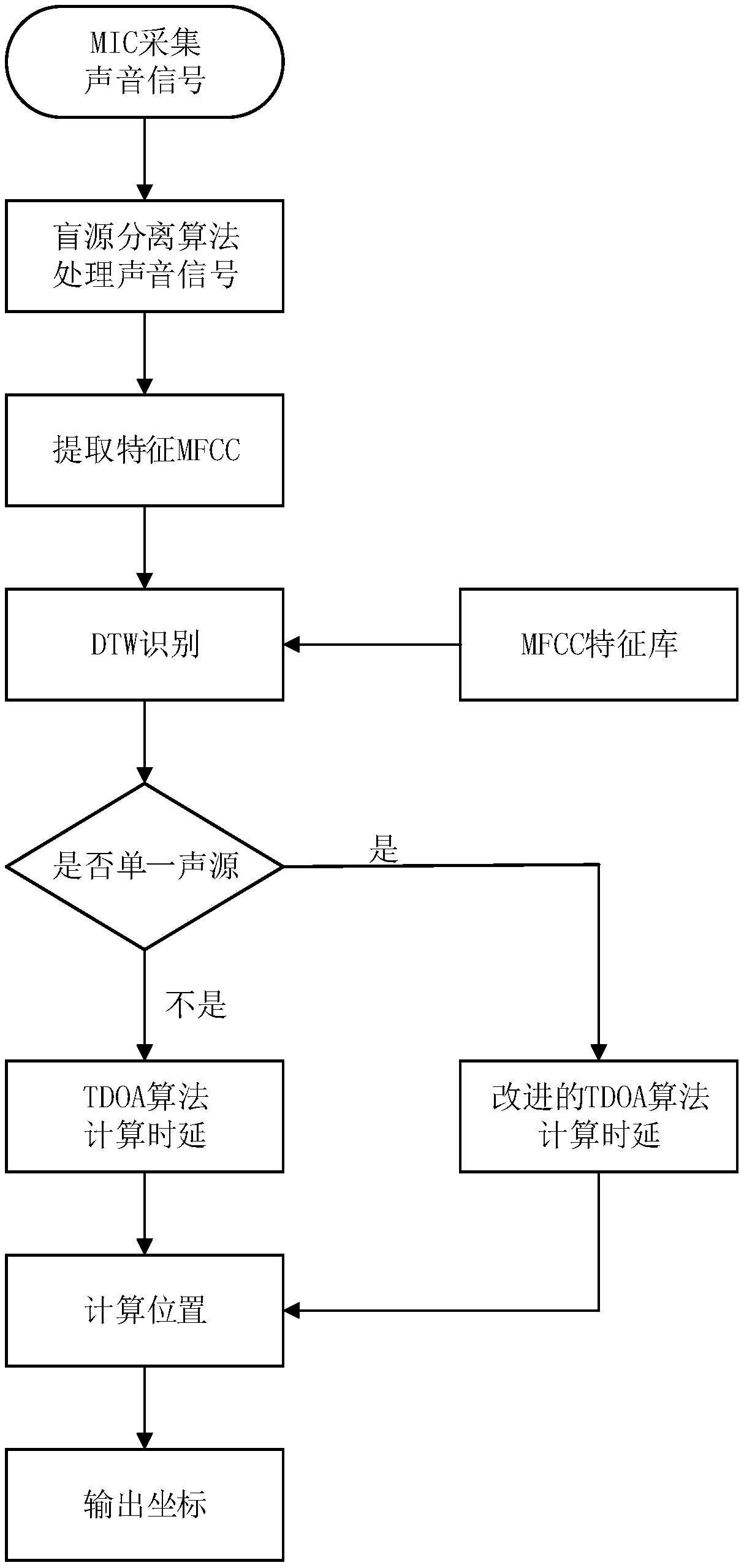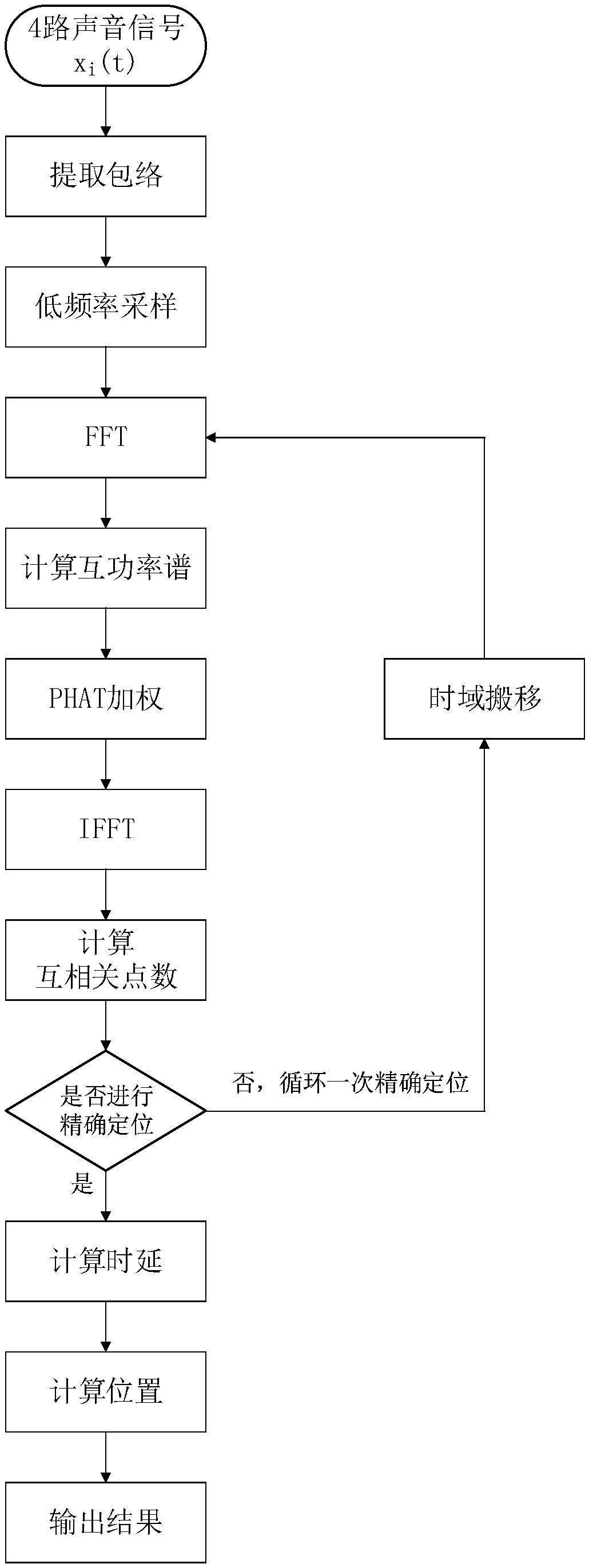Improved sound source localization method based on progressive serial orthogonalization blind source separation algorithm, and implementation system for same
A blind source separation and sound source localization technology, which is applied in positioning, radio wave measurement system, voice analysis, etc., can solve the problem of not being able to identify multiple sound sources
- Summary
- Abstract
- Description
- Claims
- Application Information
AI Technical Summary
Problems solved by technology
Method used
Image
Examples
Embodiment 1
[0102] An improved sound source localization method based on progressive serial orthogonalization blind source separation algorithm, such as figure 2 shown, including the following steps:
[0103](1) The sound signal is collected and stored through the microphone array; the microphone array is: select (0,0,0), (a,0,0), (0,a,0), (0, 0, a) Microphones are placed in four positions to obtain the microphone array, a is a fixed parameter, representing three coordinates (a, 0, 0), (0, a, 0), (0, 0, a) to The distance from the microphone at the origin (0,0,0) of the coordinate system. The sound signal collected by the microphone array is the mixed sound signal x(t), x(t)=[x 1 (t), x 2 (t), x 3 (t), x 4 (t)], x 1 (t), x 2 (t), x 3 (t), x 4 (t) are shown in formulas (IX), (X), (XI) and (XII) respectively:
[0104] x 1 (t)=a 11 the s 1 +a 12 the s 2 +a 13 the s 3 +a 14 the s 4 (Ⅸ)
[0105] x 2 (t)=a 21 the s 1 +a 22 the s 2 +a 23 the s 3 +a 24 the s 4 (X) ...
Embodiment 2
[0115] According to the improved sound source localization method based on the progressive serial orthogonalization blind source separation algorithm described in Embodiment 1, the difference is that the accurate time delay is obtained according to step (5), such as image 3 As shown, the solution to the sound source position includes the following steps:
[0116] A. Set to obtain 4 channels of sound signals through step (3), namely x 1 (t), x 2 (t), x 3 (t), x 4 (t), t is the serial number of sampling point in the digital signal, and length is N, carries out window filter processing with 4 road sound signals, eliminates noise;
[0117] B. Extract the envelope of the 4-way signal, only take the upper half of the envelope as the effective signal, and perform sampling at the frequency of Fs / n to obtain x′ 1 (t), x' 2 (t), x' 3 (t), x' 4 (t), Fs is the sampling frequency during blind source separation, and n is an integer greater than 1;
[0118] C, for x' 1 (t), x' 2 (...
Embodiment 3
[0134] According to the improved sound source localization method based on the progressive serial orthogonalization blind source separation algorithm described in embodiment 1, the difference is that in the step (4), if there are multiple sound sources, the TDOA algorithm is used to calculate Delay, to solve the sound source position, including the following steps:
[0135] a. Step (2) obtains the independent component that needs to be positioned as y i (t), i is an integer and 1≤i≤4, t is the serial number of the sampling point in the digital signal, and y i (t), x 1 (t), x 2 (t), x 3 (t), x 4 (t) The 5-way signals are processed by windowing and filtering, and then transformed into the frequency domain by Fourier transform to obtain the frequency domain signal Y i (k), X 1 (k), X 2 (k), X 3 (k), X 4 (k), k is the sequence number of the digital signal sampling point corresponding to t;
[0136] b. The independent component y i (t) As a reference signal, calculate Y ...
PUM
 Login to View More
Login to View More Abstract
Description
Claims
Application Information
 Login to View More
Login to View More - R&D
- Intellectual Property
- Life Sciences
- Materials
- Tech Scout
- Unparalleled Data Quality
- Higher Quality Content
- 60% Fewer Hallucinations
Browse by: Latest US Patents, China's latest patents, Technical Efficacy Thesaurus, Application Domain, Technology Topic, Popular Technical Reports.
© 2025 PatSnap. All rights reserved.Legal|Privacy policy|Modern Slavery Act Transparency Statement|Sitemap|About US| Contact US: help@patsnap.com



